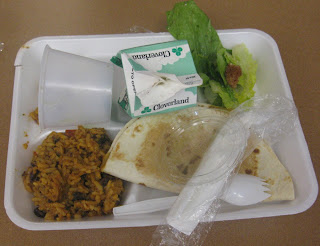 By Ed Bruske
By Ed Bruskeaka The Slow Cook
Believe it or not, many kids go through the lunch line at school and then barely touch the food. It just gets tossed in the trash. I'm not sure how the children make it through the day, but so many of them just nibble.
This is what one boy's tray looked like near the end of lunch hour. He didn't even take a bite out of the cheese quesadilla--nor the beans and rice, nor the salad. The only thing he ate was a little cup of apple sauce. But look! He drank his milk! Who says kids won't drink plain milk?
This tells me that kids are served way more food than they actually need. They typically ignore vegetables and anything else that looks suspicious--like brown rice mixed with beans and tomato sauce.
 To make sure my eyes weren't deceiving me, I took a slow walk around the lunchroom and observed closely what the kids were doing with their rice and their salad. I counted exactly six kids eating the rice. Two of them were Hispanic, one Asian. My daughter, the carbohydrate hound, wolfed hers down and went back for seconds (she was denied).
To make sure my eyes weren't deceiving me, I took a slow walk around the lunchroom and observed closely what the kids were doing with their rice and their salad. I counted exactly six kids eating the rice. Two of them were Hispanic, one Asian. My daughter, the carbohydrate hound, wolfed hers down and went back for seconds (she was denied).Fewer still ate the salad. I don't understand that. It's Romaine lettuce with croutons, not that stale, commercial mix of iceberg and shredded carrots and cabbage the schools used to serve. All that salad, along with the rice and beans, simply gets dumped in the garbage.
The kids were a bit more enthusiastic about the cheese quesadillas. In fact, I'd say Mexican food is a pretty safe bet in school cafeterias.



What kinds of foods are these kids introduced to at home? Beans & rice are simple (and cheap) to make and easy to keep stock in the pantry for busy work/school night dinners. Salads should be eaten several times a week just to balance out your meal. I’m sorry to speculate blame on the parents – but just what is being served at home?
ReplyDeleteMy observation about kids and unfamiliar foods is that they are a lot less likely to eat anything that is served in combination (rice mixed with beans, etc.) I believe this is not excessive picky-ness but a sensible thing for a young mammal designed to be a hunter and gatherer. If you are eating a food and you suddenly encounter (or see) an unfamiliar texture or a foreign substance, you'd shy away from eating it. This is what makes having adults on hand actually eating the food so important. Kids might not eat it the first time around, but after a while if they see adults eating and enjoying their food they are more likely to try it.
ReplyDeleteIf you want kids to be immediately more receptive to a food, split it up into its parts - rice next to beans, etc. Foods with a dirt or rock-like texture (beans, nuts, seeds) especially need to be served alone and clearly visible.
Somewhere around age 8 my kids finally started to get over this, but what really has made a huge difference is that my husband has started making a point of being home for dinner and eating everything on his plate, too.
On that tray, my daughter, age 12, would have eaten the salad, picked around the edges of the quesadilla, and that's about it. She likes beans and rice, but the addition of tomato sauce would have made them inedible in her eyes--she still hasn't grown out of that little-kid distrust of anything "mixed" or with sauce on it.
ReplyDelete